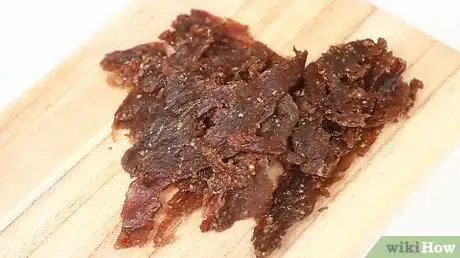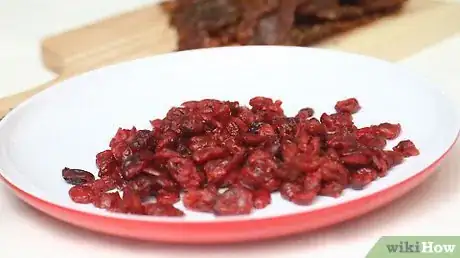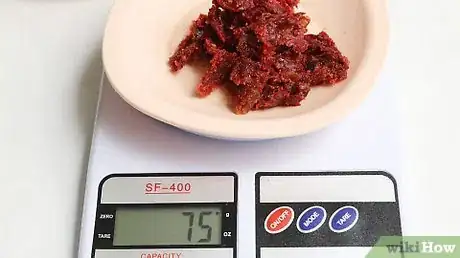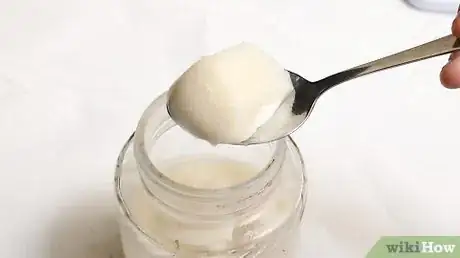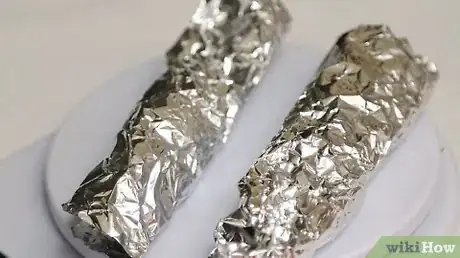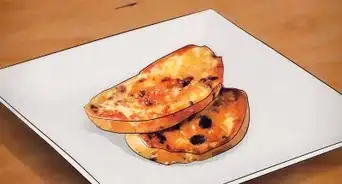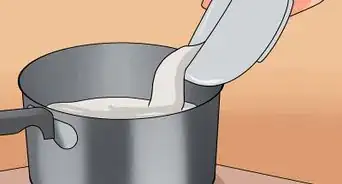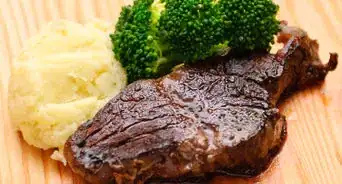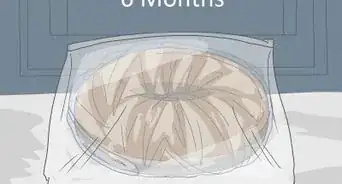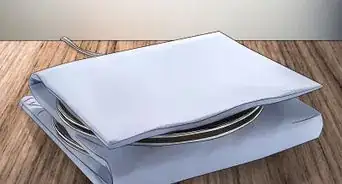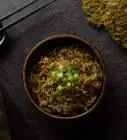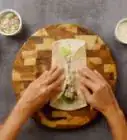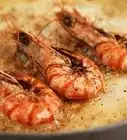This article was co-authored by wikiHow staff writer, Jessica Gibson. Jessica Gibson is a Writer and Editor who's been with wikiHow since 2014. After completing a year of art studies at the Emily Carr University in Vancouver, she graduated from Columbia College with a BA in History. Jessica also completed an MA in History from The University of Oregon in 2013.
The wikiHow Video Team also followed the article's instructions and verified that they work.
This article has been viewed 45,958 times.
Learn more...
Pemmican is a traditional Native American food known to last for years when it's prepared properly. To make your own, choose high-quality ingredients, such as dried fish or meat, dried berries, and fat. Grind the protein and berries until they're powdery and then mix them with warm rendered fat to make a thick paste. You can spread the pemmican flat and cut it into strips or shape it into a log for easy slicing.
Ingredients
- 1⁄4 pound (110 g) of dried fish or red meat (such as salmon, deer, beef, or caribou)
- 1/2 cup (75 g) of dried berries (such as Saskatoon berries, blueberries, or cranberries)
- 1/2 cup (100 g) of rendered fat or bacon grease
- 1/8 teaspoon (0.7 g) of salt
- 1/8 teaspoon (0.3 g) of freshly ground black pepper, optional
Makes about 1 cup (340 g) of pemmican
Steps
Grinding the Meat and Berries
-
1Choose dried meat or fish. You can make pemmican with your choice of protein or a combination of proteins. Purchase salmon, deer, beef, or caribou that don't contain preservatives or added flavorings or dry your own. To dry your own, start with 3⁄4 pound (340 g) of fresh meat or fish since it will lose weight as it dries. Briefly cook it in a 350 °F (177 °C) oven and turn it off. Leave it to dry in the oven for about 1 day.[1]
- For a hands-off way to dry meat or fish, put the prepared meat in a dehydrator and dry it for 8 to 12 hours.
- For pemmican that has the most nutritional value, choose grass-fed meat instead of grain-fed meat. Grass-fed cows ingest more nutrients that are passed on in the meat, such as omega-3s, vitamins B1 and B2, and vitamin E.
-
2Select dried berries. Most pemmican recipes rely on using equal amounts of dried fish or meat and dried berries. Dry your own or buy dried berries, such as Canadian Saskatoon berries, blueberries, or cranberries. To dry your own, start with about 3/4 cup (225 g) of fresh berries. Spread them on a baking sheet and cook them at 150 °F (66 °C) for up to 10 hours or put them in a dehydrator for 10 to 16 hours.[2]
- The berries will add a tangy flavor to the pemmican. If you don't want the flavor, you can leave the berries out and double the amount of dried meat or fish.
Advertisement -
3Grind the dried berries until they're powdery. Put 1/2 cup (75 g) of dried berries into a mortar and use the pestle to crush the berries. Since the berries have lots of very tiny seeds, you'll need to spend about 20 minutes to grind the berries into a fine powder. Transfer the powdered berries to a bowl.[3]
Tip: To save time, you can grind the dried berries and dried meat or fish together in a food processor.
-
4Weigh the dried ingredients to ensure they're equal. Once you've got your dried protein and dried berries, weigh them separately. You should plan on using the same weight of dried ingredients.
- Save excess meat, fish, or berries for another use.
-
5Grind the dried meat or fish until it's powdery. Put 1⁄4 pound (110 g) of your dried fish or red meat into the mortar. Pound and grind the fish or meat until it's powdery like the dried berries.[4]
- It should only take 5 to 10 minutes to pound the meat since there aren't tiny seeds.
-
6Combine the dried berries and meat or fish. Spoon the powdered berries onto the powdered meat or fish in the mortar. Then use the pestle to grind and mix them together.[5]
- If you used a food processor to grind the ingredients, you can skip this step.
Warming the Fat
-
1Choose a rendered fat to use in the pemmican. You can render your own fat if you have a high-quality source of meat fat, such as grass-fed beef or elk. Start with at least 1 cup (200 g) of fat and shred it until it's crumbly. Heat it over low for 2 to 3 hours so impurities float to the top and strain it to use in the pemmican. To save time, you can purchase rendered fat and then measure out as much as you need. Look for fats from beef, elk, bison, or caribou.[6]
- Although you can use pork or lamb fat, they don't contain the same nutritious fatty acids as grass-fed red meats have.
- If you want to render bacon grease, it's important to heat it slowly over low heat until all of the water evaporates from the grease.
Tip: Avoid using vegetable oil, shortening, or butter in the pemmican. These can separate and they don't contain the nutrients that fat from red meat has.
-
2Put 1/2 cup (100 g) of rendered fat into a saucepan. To make it easier to measure the rendered fat of your choice, let it come to room temperature. Then spoon it into a 1/2 cup (100 g) measuring cup and pour it into a small saucepan.[7]
- Most rendered fats that you purchase will be solid, but if you're using homemade rendered fat that's still warm you can skip this step.
-
3Melt the fat until it reaches 120 °F (49 °C). Stick a thermometer onto the side of the saucepan and turn the burner to low. Heat the fat and stir it occasionally so it melts and warms to a temperature of 120 °F (49 °C).[8]
- It's important to prevent the fat from reaching 150 °F (66 °C) because you'll lose valuable nutrients if the fat gets too hot.
Assembling the Pemmican
-
1Stir the rendered fat into the powdered ingredients. Once the rendered fat is warm, stir it into the bowl with the powdered berries and meat or fish. To help the mixture absorb the fat, stir in a little at a time until it's all combined.
- The pemmican mixture should look moist and crumbly, but you shouldn't see any liquid or fat pooling in the bottom of the bowl.
-
2Season the pemmican, if desired. Since pemmican is traditionally made for its nutritional and storage qualities, it's not heavily flavored. If you'd like to make the pemmican more palatable, you can mix in 1/8 teaspoon (0.7 g) of salt and 1/8 teaspoon (0.3 g) of freshly ground black pepper.
- If you don't plan on storing the pemmican for more than 2 weeks, you can also experiment by adding ground dried mushrooms or herbs. If you're using finely ground flavorings, add up to 1 tablespoon (6 g).
-
3Wrap the pemmican in plastic wrap. Lay a large piece of plastic wrap on your work surface and spoon the pemmican onto the center. Use the back of a spoon to form it into a log shape. Then wrap the pemmican tightly with the plastic wrap.[9]
- If you'd like to make thin, flat strips of pemmican instead of a round log, spread the pemmican flat across a piece of parchment paper. Then refrigerate it until it hardens. You'll need to transfer it to an airtight container for longer storage.
Tip: You can also put the pemmican into lined small loaf or cupcake molds. Refrigerate the pemmican until the small portions are easy to pop out of the molds.
-
4Store the pemmican at room temperature. For long-term storage, wrap the pemmican log in aluminum foil and place it in a sealable plastic bag. Keep the pemmican at room temperature in a dry, dark location. For example, if you have a cellar or pantry, put the pemmican there until you're ready to use it.[10]
- If you prefer to chill the pemmican, keep it in the refrigerator. Check it periodically to ensure that moisture hasn't gotten into the pemmican, which could cause it to spoil.
-
5Use the pemmican within a few years. If you made the pemmican properly and removed all of the moisture from the ingredients, pemmican can be stored and eaten for several years. If you made a log of pemmican, peel back a bit of the plastic wrap and slice rounds off of it. You can eat the pemmican as it is, fry it in a pan until it's hot, or boil and mash it.[11]
- If you made thin, flat strips, it's best to treat the pemmican like jerky and eat it without cooking it further. It's also great as a garnish for crackers or flatbreads.
- Always check if the pemmican has gone bad before eating it. Look for signs of mold and smell it. If it smells rancid, throw it out.
Community Q&A
-
QuestionCan lard be used for the fat?
 Adele OrrTop AnswererLard should not be used in this recipe, for a few reasons. One, it is unwise to use pig products in a recipe that isn't being cooked. The other reason is that lard isn't solid at room temperature, which is necessary for the pemmican to solidify.
Adele OrrTop AnswererLard should not be used in this recipe, for a few reasons. One, it is unwise to use pig products in a recipe that isn't being cooked. The other reason is that lard isn't solid at room temperature, which is necessary for the pemmican to solidify. -
QuestionCan I use virgin coconut oil? Or lard from store?
 Adele OrrTop AnswererNo, you want animal fat that is solid at room temperature. Try suet, which you can find at your local butcher's counter.
Adele OrrTop AnswererNo, you want animal fat that is solid at room temperature. Try suet, which you can find at your local butcher's counter. -
QuestionCan you add nuts to pemmican?
 Adele OrrTop AnswererYou sure can! You can try any kind of nut, dried fruit, and even herbs and spices! Just make sure any ingredients you use are completely dry, as any non-dry ingredients will cause your pemmican to go bad.
Adele OrrTop AnswererYou sure can! You can try any kind of nut, dried fruit, and even herbs and spices! Just make sure any ingredients you use are completely dry, as any non-dry ingredients will cause your pemmican to go bad.
Things You'll Need
- Measuring cups and spoons
- Mortar and pestle
- Bowl
- Spoon
- Plastic wrap
- Small saucepan
- Thermometer
- Sealable plastic bag
- Molds, optional
- Digital scale, optional
References
- ↑ http://www.traditionaltx.us/images/PEMMICAN.pdf
- ↑ http://www.traditionaltx.us/images/PEMMICAN.pdf
- ↑ https://www.acanadianfoodie.com/2017/04/11/homemade-pemmican/
- ↑ https://www.acanadianfoodie.com/2017/04/11/homemade-pemmican/
- ↑ https://www.acanadianfoodie.com/2017/04/11/homemade-pemmican/
- ↑ http://www.traditionaltx.us/images/PEMMICAN.pdf
- ↑ http://www.traditionaltx.us/images/PEMMICAN.pdf
- ↑ http://www.traditionaltx.us/images/PEMMICAN.pdf
- ↑ http://www.traditionaltx.us/images/PEMMICAN.pdf
